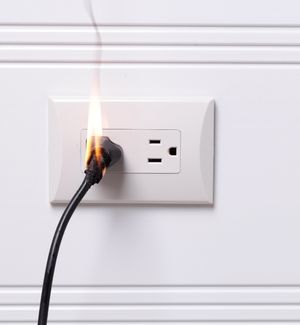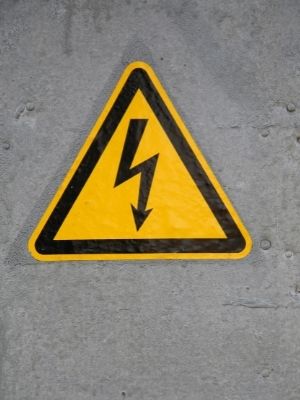Now and then, the internet allows for some really interesting scientific debates on forums rather than the usual bickering. But, you can still come away with conflicting opinions. A good example of this is the idea that fire can conduct electricity. Some people say that it isn’t possible, others that say it is, and those that say it all depends on the situation. So, who’s right?

Generally, fire will not conduct electricity. But, that doesn’t mean that you can’t conduct a charge under the right conditions. It is all about the presence of plasma and ionized air. This is unlikely with a controlled flame at home but possible in a major blaze.
If we are going to fully appreciate the science behind all this and the potential for a strong electrical charge through a fire, we need to break the subject down. Let’s discuss the following in more detail.
- What is plasma?
- What is ionization?
- How does this relate to fire and its conductivity?
- The likelihood of fire conducting electricity at home vs a major blaze.
- Other important risks with the relationship between electricity and fire
Table of Contents
Conducting electricity to create a current.
The concept of electricity passing through anything that isn’t a wire can be a difficult concept if you are well-versed in physics. Electricity flows from outlets to devices through cables and that’s about all we need to know when powering our homes.
However, an electric current doesn’t rely on wires to travel. The wires are just a simple way of containing ionized atoms and free electrons. This minuscule pathway allows for the flow of energy with the right voltage.
Therefore, if you can generate the right conditions for this conductive atmosphere, it could be possible to conduct electricity and create a pathway without the need for wires.
The next question is what this has to do with fire. Fire is a chemical reaction where a combination of high temperatures, adequate fuel sources, and oxygen levels lead to combustion and the generation of flames.
There is no obvious pathway here. However, there is a way that fire can develop into a conductive state. It is all about the presence of plasma and ionization.
What is plasma?
There are actually two forms of plasma that you may come across in science. One relates to our blood, which has nothing to do with fire as it is not a biological organism.
The other is plasma in a fourth state. Going back to those basic science lessons from high school, you will know that there are three common physical states.
A good way to explain this is through fire’s nemesis: water. In its typical form, water is a liquid that flows from our faucets for drinking and washing.

But, we can also freeze water into ice and turn it into a solid. Or, we can heat it up and create steam so it is in a gaseous state.
Then there is a fourth state, known as plasma. This state is a gas made from ions with some orbital electrons stripped away.
Although it is the one we are less familiar with, it is actually one of the most abundant in the universe. Stars and our own sun consist of a lot of plasma. You can also find it in fission reactors.
Is fire plasma?
Fire doesn’t conform to these rules of physics because of the reaction taking place. There are solid materials in the smoke from an incomplete burn and occasionally some water vapor or gases.
But, the flames are different.
Generally speaking, fire isn’t considered to be plasma because of the ion density. But, that doesn’t mean that it can’t develop into a plasma state under the right conditions.
There are intense blazes with high temperatures that allow for greater ionization of the flames and air around it. While there may be disagreements over the precise levels needed to create plasma, it is certainly possible for plasma to form.
In doing so, the fire could become conductive enough to allow for the transfer of an electric current.
What is ionization?
The other crucial part of this process is the ionization of the atmosphere to conduct the current.
Ionization is basically the process where the structure of an atom is compromised and electrons break out of the shell. This leads to a positively charged ion, due to the loss of electrons and the presence of free electrons.
All you need is the right change in heat or energy to create this process, which is why intense fires can lead to ionization.
How does fire conduct electricity?
Now that you have a series of free-moving electrons and positive ions, rather than a static form of neutral ions, you have a conductive environment.
Adding a voltage to the atmosphere creates a current as the electricity has that freedom to move – much like it would along a suitable wire. You need a pretty strong voltage for this to work.
But, that need diminishes if you have strong ionization and the presence of a plasma-state fire.
The current conducted by the fire is then free to move and flow through the fire. The course of the current will depend on whether a suitable ground conductor is touching the fire.
Interestingly, the current doesn’t necessarily die when the fire goes out. A strong arc can remain in a charged atmosphere after the flames are gone.
How likely is it that a fire will conduct electricity?
The good news is that these cases are very rare. A fire has to become pretty intense for it to turn to a plasma state and have the right level of ionization for an electric current.
Therefore, if there is a fire in your home or workplace, you shouldn’t have to worry about the blaze picking up any electrical currents and sending them through the room.

You would have to put a lot of work into manipulating the temperature and providing a high enough voltage to the fire to create any sort of arc.
This isn’t going to happen by accident.
The same is true for any controlled fire pits and campfires. These fires are as safe as fires can be as long as you use the right fuel and don’t leave them unsupervised.
Can a candle flame conduct electricity?
The risk here goes back to that idea of a plasma-state fire being an intense burn with controlled and manipulated conditions.
Under laboratory settings, it wouldn’t be impossible to create a flame from a burner and send a current across. When you have a flame from the wick of a candle, you have a low-temperature fire and a very small burn.
This isn’t going to be enough for the ionization process or the creation of plasma. Some say that you might be able to counter the low level of free electrons with a high enough voltage, but it is unlikely.
How do electrical fires start?
While all of this sounds like the basis of an interesting science experiment, it is important to remember that fire and electricity don’t mix and you shouldn’t do anything to deliberately bring them together.
A conductive blaze that carries an arc of electricity is difficult to control and destructive enough to cause serious damage and fatalities.
There is also the fact that electricity and water don’t go together because of the severe risk of an electric shock. This is a problem when trying to tackle fires in an area with live wires
Another important problem to keep in mind is that a lot of structural fires are electrical fires. Bad wiring and appliance failures can lead to short circuits and high temperatures that start a blaze.
A common issue is overloading extension leads out expecting too much from a single outlet. Then there are cases where old appliances and circuit breakers simply develop faults. There is also the risk of batteries in devices overheating or breaking down.
If you want to know more about this, you can check out my guide on whether batteries can catch fire.
Whether you end up dealing with faulty batteries or wiring, it is important to know how to deal with the fire.
Small electrical fires are manageable if you can turn the device off at the main outlet to disrupt the power, and if you can smother the flames. If this is too difficult or the fire is substantial, leave the room, close the doors, and call for help from the fire service.
To wrap things up, it is important to remember that there is very little risk of danger when you have controlled flames at home. Fire can conduct electricity with the processes of plasma generation and ionization, but that is unlikely outside of major situations.
Instead, it is important to be more mindful of how electronic items and electricity supplies can cause fires around the home.